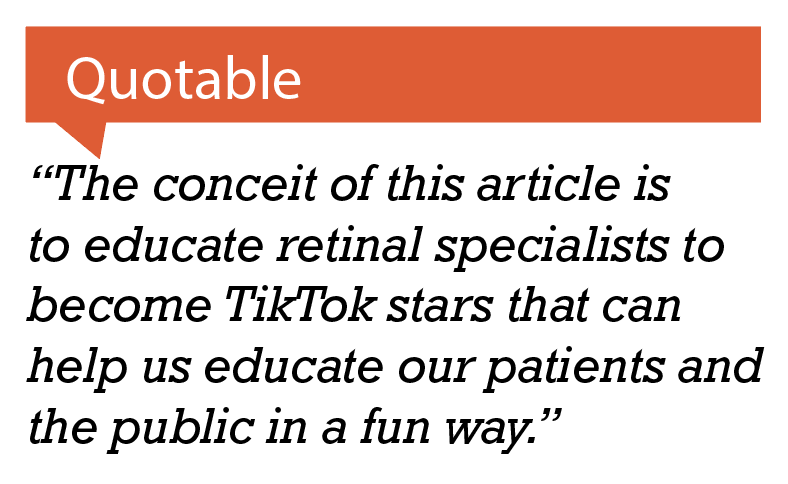 |
|
Bio Dr. Sridhar serves as Retina Specialist Magazine’s Social Media Ambassador. He’s an associate professor of clinical ophthalmology at Bascom Palmer Eye Institute, Miami. DISCLOSURE: Dr. Sridhar is a consultant to Alcon, DORC, Genentech/Roche and Regeneron Pharmaceuticals. |
“...but the party don’t stop.” No, TikTok isn’t referring to the 2009 pop hit by Ke$ha, but rather to one of the most popular social media platforms in the world. Created by the Chinese company ByteDance, TikTok was released to an international audience in late 2017 and captured the attention of users worldwide for its short-form video format. As of today, there are over one billion users of TikTok monthly worldwide and nearly a quarter of all internet users are using TikTok.
TikTok’s impact is so profound that it has spread into ophthalmology. If we dig into the literature, there have been a few ophthalmology studies examining its impact. Tiffany Cheng and her co-workers1 from the Albert Einstein College of Medicine in New York described 386 oculoplastic-related videos on the platform with over 218 million views. Ironically, they discovered that not only were patients the most likely group to post these videos, but also that oculoplastic surgeon-created videos were the least likely to be shared. As you would expect, physician content was statistically more likely to be understandable.
University of Miami research student, Tiffany Eatz, and her team2 looked at both TikTok and Instagram posts related to strabismus and found that the former were statistically more likely to achieve likes and new followers. They also noted that negative posts regarding the strabismus surgery experience were more likely to be liked than positive posts. Finally, from the Baylor College of Medicine in Houston, Ritu Sampige and her team3 examined TikTok posts with 37 ophthalmology-related hashtags over about a one-month period. They discovered that the vast majority of posts were created by non-physicians, and these posts were more likely to include misinformation. More alarming, misinformation posts received more likes and shares!
 |
All of this helps us arrive at the conceit of this article: To educate regular retinal specialists to become TikTok stars that can help us educate our patients and the public in a fun way. Compiling tips from TikTok stars and the TikTok developers themselves, here are the top seven tips for creating a viral TikTok video:
1. Use a 9:16 aspect for a full screen experience.
2. Include some combination of voiceover, music and sound effects.
3. The shorter the better; aim for under 30 seconds.
4. Use at least 720p video resolution, but your mobile phone is enough!
5. Make sure your lighting is bright.
6. Use the hashtag “Popular Trends” to see what is getting views on TikTok and try to match.
7. Recruit well-known TikTok creators to collaborate.
What’s missing from the list? Content choice! In the end, your choice of content will be less important than how you deliver your message. You could talk about geographic atrophy, intravitreal injections, diabetic retinopathy, retinal detachment surgery…the list goes on and on. So go out there, retinal specialists, and make some videos! RS
1. Cheng T, Wang F, Barmettler A. #Oculoplastics: An analysis of TikTok’s top oculoplastics content. Ophthalmic Plastic and Reconstructive Surgery. 2022;38:5:452-457.
2. Eatz TA, Kalavar M, Birnhak M, et al. The role of social media in strabismus surgical experience. Journal of Pediatric Ophthalmology & Strabismus. 2023;60:6:402-405.
3. Sampige R, Rodgers EG, Huang A, et al. Education and misinformation: Exploring ophthalmology content on TikTok. Ophthalmology and Therapy. 2024;13:1:97-112.



